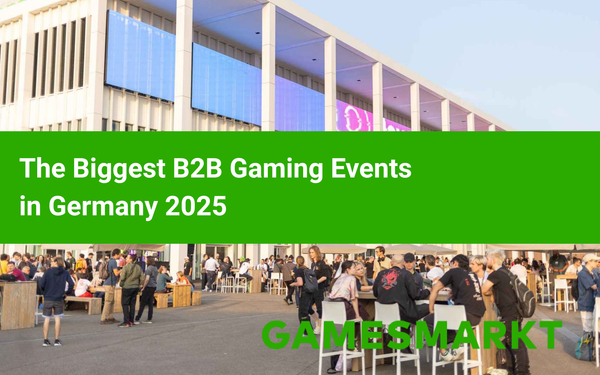From Ray Tracing to Path Tracing in Games


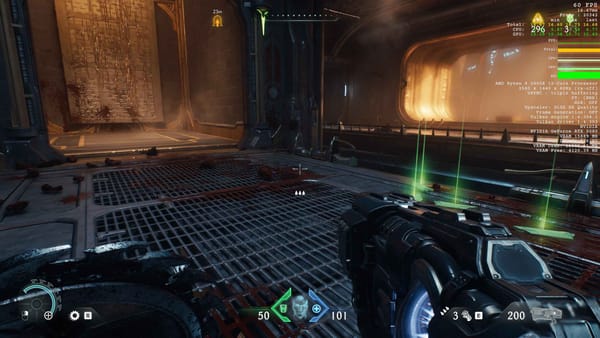
Ray Tracing is already used in over 250 PC games, and the number of titles using Path Tracing is slowly increasing. What are the differences, and how do they affect visuals and performance?
First, let's take a brief, concise and simplified look at the concepts and their basic functionality. Ray Tracing and Path Tracing are rendering techniques used in 3D computer graphics to create realistic light and shadow effects, as well as reflections. However, they differ in their complexity and approach to simulating light, as well as in how they differ from Rasterisation.
In Rasterisation, which is still widely used, a 3D scene is converted into pixels from a specific camera perspective. The geometry is converted directly into pixels, whereby only what is visible is calculated. Light and shadows are usually simulated using simplified methods, such as shadow maps or screen space effects. These methods were developed to save computing power while achieving the best possible representation of the 3D scene. However, rasterisation has limitations when it comes to objects outside the field of view (e.g. reflections from objects that are not currently visible in screen space), dynamic conditions, and complex scenes.
This is where Ray Tracing comes into play. It is sometimes used as a complementary method for certain aspects of rasterisation. In Ray Tracing, light rays are traced from the camera through the 3D scene. For each pixel in the image, a ray is emitted and hits objects in the scene. (It is the reverse of how the human eye works, where light rays from the environment hit the retina.) As soon as a ray hits an object, additional rays are generated to calculate reflections, refractions, and shadows. However, the number of these secondary rays is limited to keep calculation times within reasonable limits. Ray Tracing can therefore be used to create realistic reflections, mirror images and shadows. It is particularly effective with direct light sources and how they interact with surfaces. Although the technique is computationally intensive, modern graphics cards now make it suitable for real-time applications such as games.
Popular areas of application include reflections of objects outside the field of view (screen space reflections are limited here), ambient occlusion, and the global illumination of the game world by a light source (ray-traced global illumination). Before Nvidia's RTX graphics cards with hardware acceleration for Ray Tracing (RT cores) entered the world of real-time rendering in games with the GeForce 20 series, unveiled on 20 August 2018 ahead of gamescom, it was possible to perform Ray Tracing via software as well. One of the first games to have a huge visual impact was Control by Remedy.
However, as the required computing power is still very high, alternative solutions had to be implemented too. This is where Nvidia's DLSS (Deep Learning Super Sampling) comes into play. It acts as a deep learning-based upscaling technology that reduces the number of natively rendered pixels - and the number of rays that have to be calculated. The final image is then upscaled. Since then, both the hardware and the software have been further developed, with AMD and Intel also incorporating dedicated Ray Tracing units into their GPUs to accelerate Ray Tracing. Apart from requiring significantly more computing power, Ray Tracing produces better results than rasterisation, but these are still not ideal, especially with indirect lighting and many different light sources.
This is where Path Tracing enters the picture as a further development (deepening). Rather than tracking a single ray per pixel, it simulates many different light paths per pixel. A large number of rays are emitted for each pixel and travel randomly through the scene. Each of these paths can be reflected or refracted multiple times within the scene before hitting a light source (see Monte Carlo integration for more on this) – this is sometimes referred to as Full Ray Tracing rather than Path Tracing. This multitude of rays also enables indirect lighting effects, soft shadows, and complex light scattering to be rendered more realistically. The focus is on how light behaves, is distributed in a scene, and is reflected from surface to surface. Naturally, this method is significantly more complex and computationally intensive due to the greater number of rays involved.


Currently, over 250 PC games support Ray Tracing. Some titles do not allow Ray Tracing to be turned off, including The Elder Scrolls IV: Oblivion Remastered, Ninja Gaiden 2 Black, Star Wars Outlaws, Avatar: Frontiers of Pandora, and Assassin's Creed Shadows. However, all of these titles offer software solutions if there is no hardware acceleration for Ray Tracing. This is not the case for Metro Exodus Enhanced Edition, Indiana Jones and the Great Circle, and Doom: The Dark Ages. These games cannot be started without GPUs with hardware-based Ray Tracing acceleration. For Doom, for example, the minimum requirements state: "Nvidia or AMD hardware ray tracing-capable GPU with 8GB dedicated VRAM or better (examples: Nvidia RTX 2060 Super or better, AMD RX 6600 or better)."
Path tracing is still the exception in games, but this is changing. Games that use this technology include Portal with RTX, Quake 2 with RTX, Cyberpunk 2077, Desordre: A Puzzle Game Adventure, Black Myth: Wukong, Indiana Jones and the Great Circle, Alan Wake 2, Naraka: Bladepoint, Half-Life 2: RTX, F1 25, FBC: Firebreak and Doom: The Dark Ages.
The latest example of Path Tracing integration is the PC version of Doom: The Dark Ages, which recently received an update adding this feature, as well as benchmarks. Although the shooter from id Software already looks impressive with Ray Tracing at the highest quality settings, the Path Tracing option enhances the visuals, particularly the reflections on surfaces. "Additionally, NVIDIA Spatial Hash Radiance Cache (SHaRC) technology is leveraged to performantly compute path-traced light, NVIDIA Shader Execution Reordering accelerates performance, and DLSS Ray Reconstruction enhances image quality and performance," according to Nvidia. "Doom: The Dark Ages features always-on ray-traced global illumination lighting - with path tracing, light from the sun, moon, and hellish skyboxes bounces multiple times, illuminating more game elements at a higher level of detail. Bounced light can be cast onto NPCs and enemies, too, and in general everything looks even better, with light reacting more realistically."

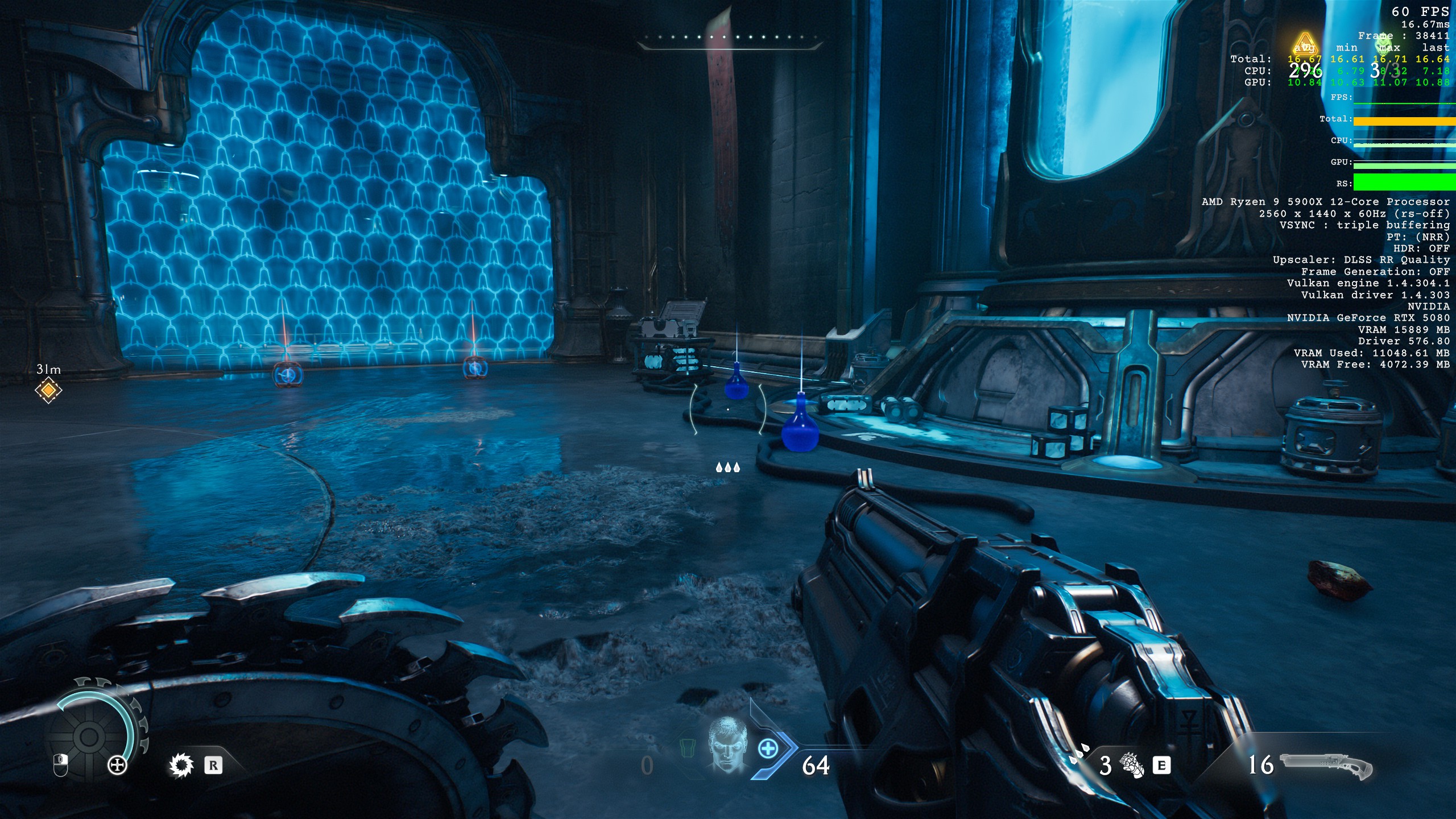
Path Tracing in Doom: The Dark Ages simulates the behaviour of more light sources (such as neon strips on the floor, fire and energy weapon effects) much more accurately and comprehensively than the Ray Tracing pendant. Light is reflected not only directly, but also indirectly via multiple surfaces, resulting in a more natural distribution of light effects throughout the level. For example, the light from flames colours the surrounding area - an effect that is barely noticeable or not noticeable at all with standard Ray Tracing.
With Path Tracing, there are many more reflections, regardless of how rough the reflecting material is - unlike the Ray Traced-only version, objects such as game pick-ups are also reflected. Additional details are reflected at a higher level of detail, and additional light bounces allow for greater reflectivity on weapon armour and other surfaces. There are also more indirect and smaller light sources. These effects are particularly noticeable indoors. Additionally, shadows are rendered more accurately and, in some scenes, shadows are added in places where they were not present before, which contributes to the mood and atmosphere in the levels. In short, Path Tracing means better reflections on nearly all surfaces and better bounce lighting, while all lights are emissive.
In addition, there is DLSS Ray Reconstruction, which replaces traditional Ray Tracing denoisers with a unified AI model that also accelerates performance. It is available for all GeForce RTX GPUs. "DLSS Ray Reconstruction increases the stability of ray-traced effects and further reduces noise, while to reducing the frame rate cost of denoising," says Nvidia. This mainly makes reflections clearer.
Using Path Tracing naturally requires a lot more processing power, which is currently only available in high-end or enthusiast graphics cards and PC systems. The following benchmarks were taken on an AMD Ryzen 9 5900X processor with 64 GB of DDR4 3200 MHz RAM and an MSI GeForce RTX 5080 Inspire 3X graphics card with 16 GB of VRAM. Both Doom: The Dark Ages and Windows 11 were installed on an NVMe SSD Gen 4 and no other processes were running in the background. HDR was not enabled. The advanced graphics options were set to 'Ultra Nightmare' with a texture pool size of 4096. Motion blur and Nvidia Reflex were enabled. Resolution scaling and V-Sync were disabled. The graphics card was provided by Nvidia (without conditions) for testing purposes only.
With Path Tracing enabled, DLSS Ray Reconstruction was selected as the denoiser, as well as Ray Tracing for shadows from all light sources and for transparency and water reflections. In short, the maximum possible graphics quality settings were used.
2560x1440p TAA
Path Tracing: 34.39 (42.09)
Ray Tracing: 93.88 (133.82)
2560x1440p DLAA
Path Tracing: 33.91 (40.61)
Ray Tracing: 88.11 (106.19)
2560x1440p AMD FSR Native AA
Path Tracing: 33.98 (41.10)
Ray Tracing: 88.63 (105.65)
2560x1440p DLSS Quality
Path Tracing: 60.83 (72.66)
Ray Tracing: 128.40 (159.69)
2560x1440p DLSS Balanced
Path Tracing: 71.33 (84.24)
Ray Tracing: 149.16 (179.40)
2560x1440p AMD FSR Balanced
Path Tracing: 70.60 (84.12)
Ray Tracing: 155.62 (187.38)
2560x1440p DLSS Performance
Path Tracing: 88.06 (102.95)
Ray Tracing: 164.34 (195.45)
2560x1440p DLSS Ultra-Performance
Path Tracing: 122.55 (155.74)
Ray Tracing: 209.51 (249.07)
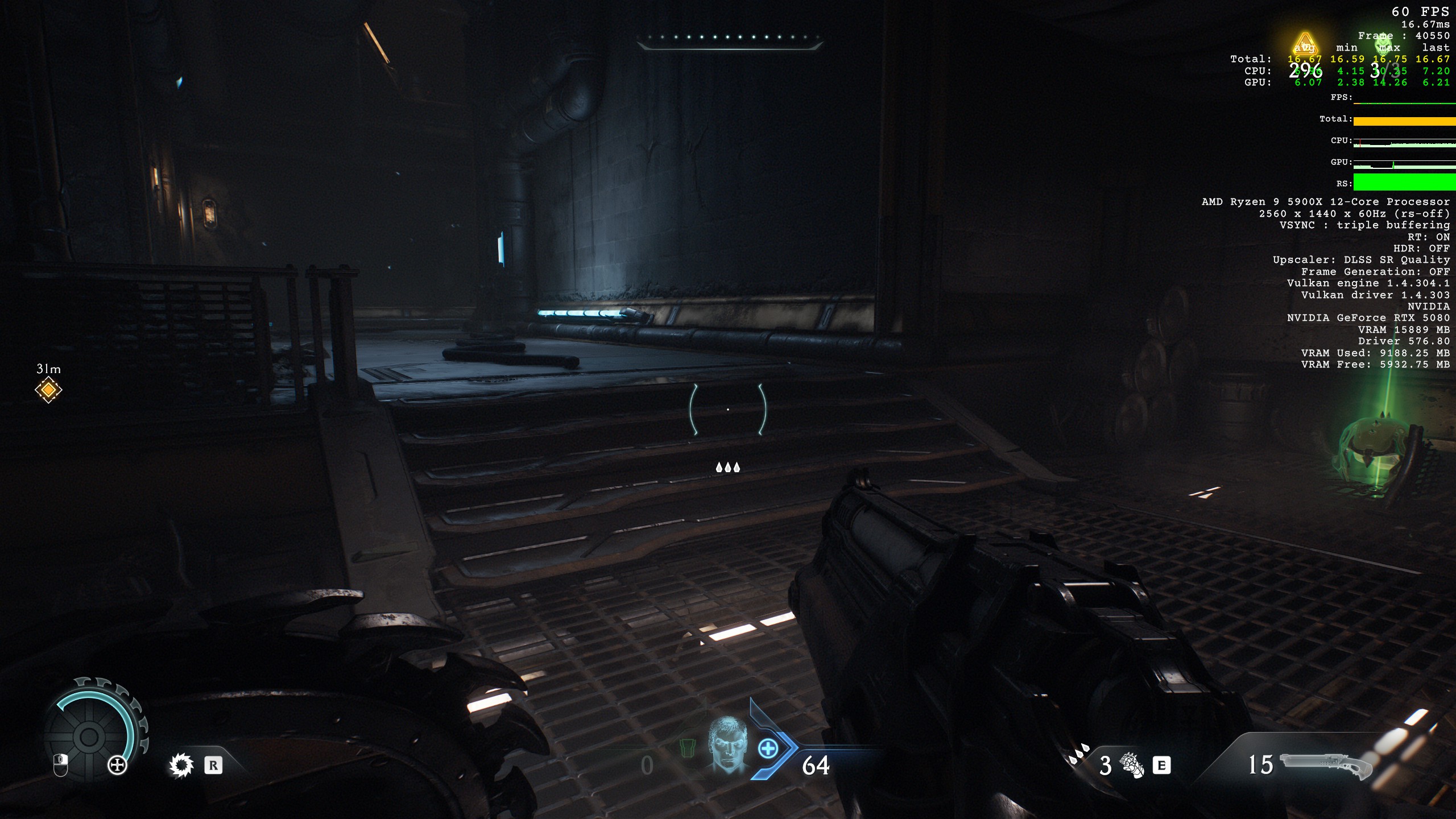
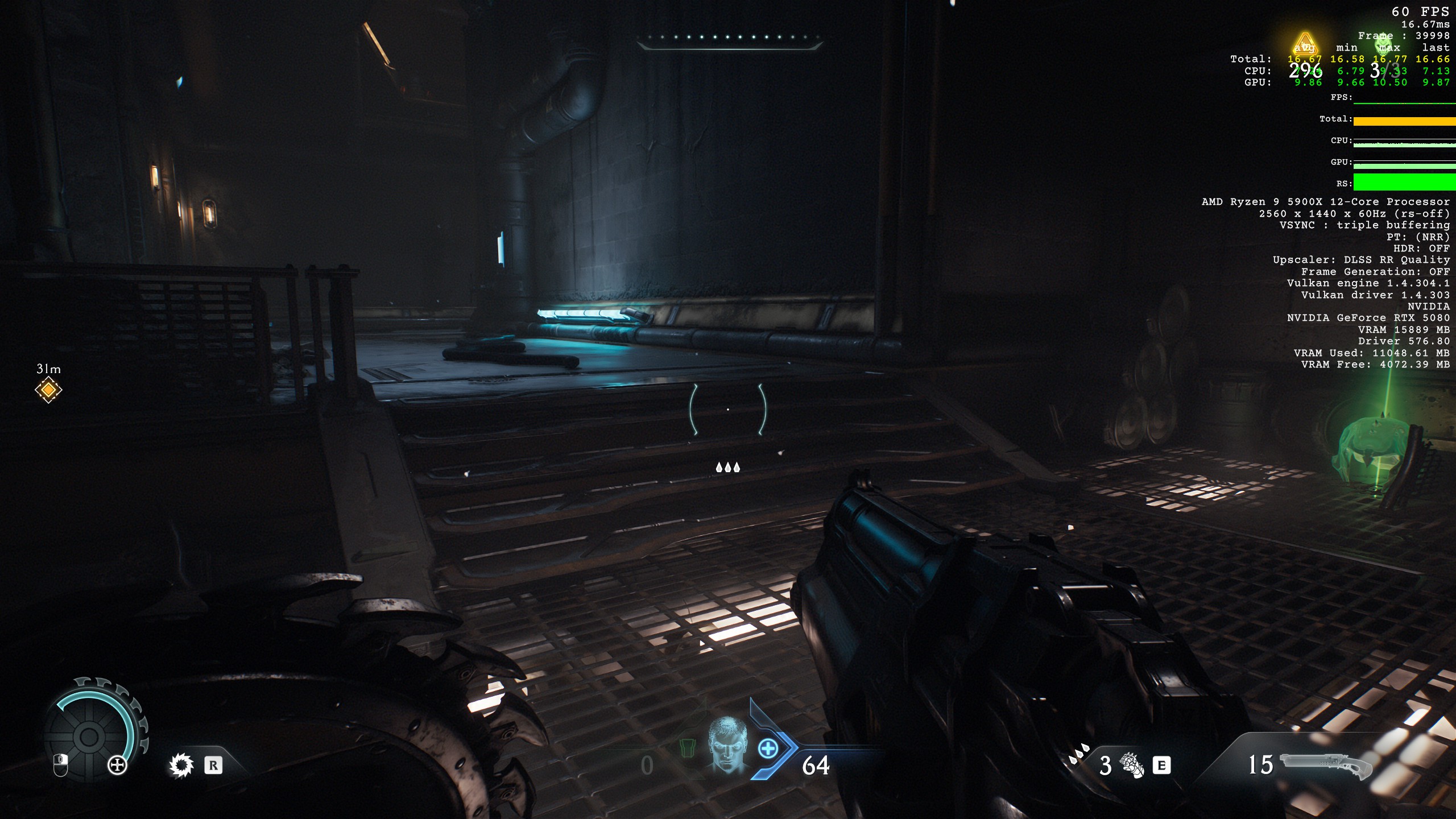
It should come as no surprise that performance largely depends on how many native pixels are being calculated. If fewer pixels and their rays are calculated and then upscaled, performance improves significantly. In this scenario, it would also make sense to activate Frame Generation from the Quality setting onwards (at 2560x1440p), although this depends on the specific benchmark scenario; other parts of the game may be more demanding. As is well known, Frame Generation should only be activated if the game is already running at around 60 fps. This ensures that input latency is not impacted too much.
The further the DLSS model is pushed towards Ultra Performance, the blurrier and more artefact-ridden the results become; however, frame rates also increase. Additionally, native Path Tracing without a super-resolution solution remains highly performance-intensive, even with today's high-end graphics cards. Upscaling methods such as DLSS are therefore essential for making Path Tracing feasible, especially in fast-paced games like Doom, where 60 fps should be the minimum.
As frames calculated using Frame Generation in Doom: The Dark Ages are not included in the benchmark results, screenshots were taken at five locations with Path Tracing at 2560x1440p (DLSS quality; maximum settings) using the game's internal performance tools versus the running benchmark results.
Without Frame Generation / with MFG 2x - 62.19 / 107
- 64.85 / 108
- 73.45 / 123
- 62.07 / 108
- 61.34 / 101
Without Frame Generation / with MFG 3x - 61.69 / 156
- 62.26 / 153
- 73.62 / 174
- 68.15 / 161
- 61.17 / 149
Without Frame Generation / with MFG 4x - 64.70 / 186
- 63.81 / 185
- 74.23 / 210
- 67.44 / 203
- 62.17 / 192
The following benchmark results demonstrate the impact of Path Tracing on the performance of Cyberpunk 2077 (v2.21), as well as its comparison with an Nvidia GeForce RTX 3080 Ti FE. The results demonstrate that the leap in performance between the two generations of graphics cards (from Ampere to Ada Lovelace to Blackwell) is particularly noticeable in Ray Tracing and Path Tracing operations.
1440p - Preset Ultra / No RT / No Upscaling / No Frame Generation
- Avg. fps: 114.26 / 137.31
- Min. fps: 94.27 / 94.72
- Max. fps: 143.11 / 174.22
- Frames: 7341 / 8823 (+20,2%)
1440p - Preset Ultra / No RT / DLSS Quality Transformer / No Frame Generation
- Avg. fps: 108.81 / 142.83
- Min. fps: 93.82 / 94.93
- Max. fps: 134.44 / 180.37
- Frames: 6991 / 9178 (+31,3%)
1440p - Preset Ultra / No RT / DLSS Quality Convolutional / No Frame Generation
- Avg. fps: 116.71 / 144.41
- Min. fps: 97.28 / 99.59
- Max. fps: 146.11 / 179.76
- Frames: 7499 / 9280 (+23,75%)
1440p - Preset Ultra / RT Overdrive (Path Tracing) / No Upscaling / No Frame Generation
- Avg. fps: 23.78 / 38.31
- Min. fps: 17.97 / 32.25
- Max. fps: 29.82 / 45.36
- Frames: 1526 / 2461 (+61,27%)
1440p - Preset Ultra / RT Overdrive (Path Tracing) / DLSS Quality Transformer with Ray Reconstruction / No Frame Generation
- Avg. fps: 39.09 / 68.89
- Min. fps: 32.14 / 61.86
- Max. fps: 45.17 / 64.24
- Frames: 2510 / 4426 (+76,33%)
1440p - Preset Ultra / RT Overdrive (Path Tracing) / DLSS Quality Convolutional with Ray Reconstruction / No Frame Generation
- Avg. fps: 49.18 / 80.59
- Min. fps: 43.52 / 69.75
- Max. fps: 54.60 / 64.24
- Frames: 3160 / 5177 (+63,83%)
Therefore, it can be assumed that, in the future, more and more games will rely on Ray Tracing and Path Tracing to offer better graphics and more realistic game worlds, especially if hardware continues to develop at such a rapid pace. Until then, however, Path Tracing will require expensive hardware and clever solutions, such as DLSS. However, the end result is outstanding.
